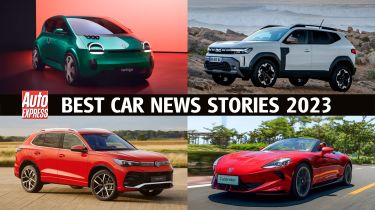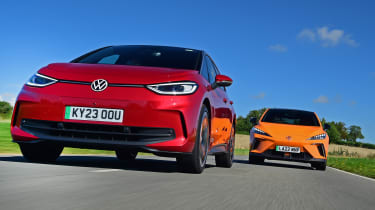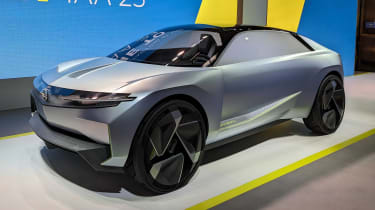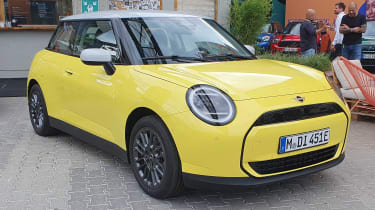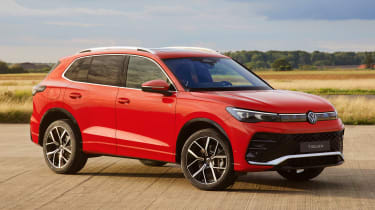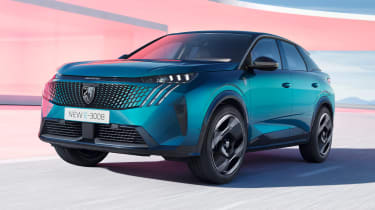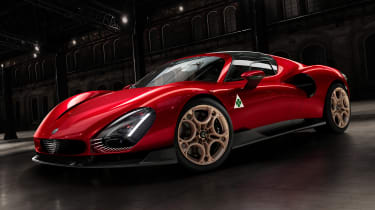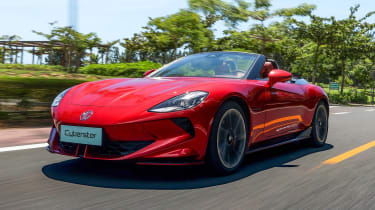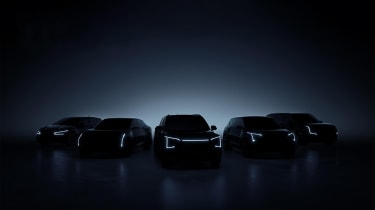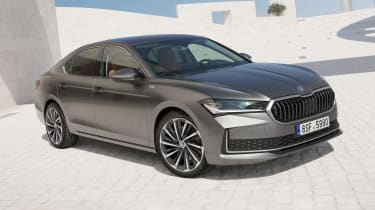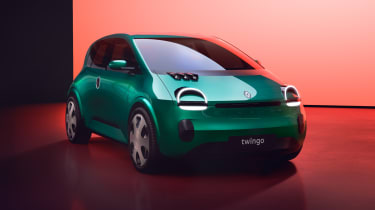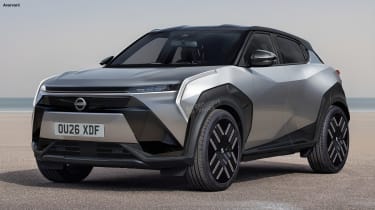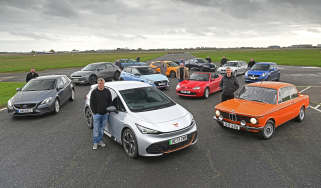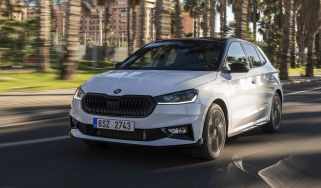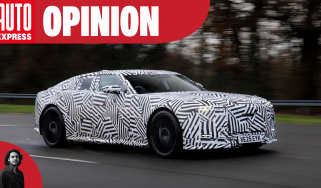Car news 2023: the year’s unmissable motoring stories: August - November
2023 went by in a flash but just look at all the huge car news that happened in the last 12 months…
August
MG beats VW and hints of a Manta return…
MG4 keeps ID.3 at bay in EV twin test
Issue 1,794’s cover story was a big one for real-world electric cars. To some, this test might have looked like a David vs Goliath battle – Volkswagen’s billion-Euro EV programme up against British-branded Chinese upstart MG – but the reality couldn’t have been further from the truth.
Previous to our test between the lightly refreshed ID.3 and the MG4, the latter had already gained critical acclaim for its impressive value as well as its entertaining drive and excellent comfort. The VW, on the other hand, had earned criticism for many of its attributes, from its unfinished dynamics and cheap trim, to its flawed digital interfaces.
Would our twin test be retribution for VW, or did MG prove it was more than just a fluke? Well both – sort of. Yes, VW had fixed a few foibles, with tangible improvements to cabin quality and some worthwhile spec updates, but the ID.3’s fundamental issues didn’t seem to disappear.
One of the main ones concerned the fiddly infotainment, which on UK cars won’t be rectified until next year, when right-hand-drive models inherit the updated system. The ID.3 also didn’t display much improvement in its ride and handling, not helped by our test car’s 20-inch wheels. However, the ID.3’s typically strong areas did show to the fullest: impressive charging speeds and range, plus good packaging, space and refinement considering its relatively small footprint. The ID.3 is expensive, however.
The MG4 did, in fact, share many of the ID.3’s issues. Cabin quality wasn’t brilliant, the user interfaces were just as fiddly, and while range and efficiency were well rated, its charging capabilities weren’t up to the VW’s level. But with such a huge gulf in price between the two cars, we had to award the win to the MG. It was far cheaper, and also came with better post-sales support thanks to a great warranty.
We noted that the MG4’s excellent package was unlikely to be challenged in the short term, but we left the caveat that the model’s expanding line-up could broaden the appeal even further. MG has launched a third, Extended Range battery size, but we still think the mid-level battery size is the sweet spot in the range.
In fact, we ran this specific MG4 as a long-term test car for the intervening four months, and found it a joy to live with. Its keeper, Richard Ingram, was uncharacteristically emotional about its departure – a telling verdict.
Experimental look at Vauxhall’s future
Vauxhall’s reinvention, since it left the GM group and joined Euro-American conglomerate Stellantis, has already seen good results. But in issue 1792 we viewed the first threads of a much bigger statement that’s on its way.
Leveraging the STLA toolkit developed by its stablemates, its Experimental concept gave us our first glimpse of a production model that’s expected to bring back the iconic Manta name. Not due until at least 2025, the coupé crossover will form a more ambitious vision for a brand with huge loyalty here in the UK.
September
The Munich Motor Show delivered a bumper load of new cars…
MINI takes limelight in Munich
What better way to start the month than with some shiny new metal, although this year’s Munich Motor Show seemed to focus on electric vehicles and future technology specifically.
The fifth generation of the beloved MINI Cooper took centre stage, flaunting a smart new look that’s based on “charismatic simplicity”, according to the brand’s head of design. Meanwhile its fresh interior is centred around an ultra-slim 9.4-inch OLED screen that can be transformed by the different ‘MINI Experience Modes’ on offer. Like before, Britain’s bundle of joy will be available with either petrol or all-electric power – the latter set to offer up to 250 miles of range – but it will only be available as a three-door model.
For those who need something a little more practical but no less stylish, the new MINI Countryman also made its debut in Munich. Based on the latest BMW X1’s underpinnings, the third-generation Countryman is bigger than the last, boosting space inside. It features the same cabin design as its smaller stablemate, and can also be had with a choice of powertrains, including fully electric power for the first time.
Competing for the spotlight was the facelifted Tesla Model 3 that made a surprise appearance and boasted improvements to refinement, a “fully redesigned” interior, styling tweaks and a deeply impressive 421-mile maximum range. But Tesla being Tesla, there was some controversy, as we saw that the updated Model 3 had ditched traditional indicator stalks in favour of buttons on the steering wheel.
Meanwhile the ‘Renaulution’ continued, with the French firm unveiling the all-new Scenic E-Tech, its answer to electric family cars such as the Hyundai Ioniq 5 and Volkswagen ID.4. The reborn Scenic combines the Nissan Ariya’s bespoke EV platform with the bold styling and Google-powered technology we love in the smaller Megane hatchback. The Scenic’s whooping 545-litre boot trumps both its rivals’, as does the 385-mile range.
BMW got us to look further into the future, unveiling the Vision Neue Klasse concept that gave us a good idea of what the next 3 Series saloon will look like, along with some details about its all-new EV platform. Mercedes also previewed its upcoming Tesla Model 3 rival, with the futuristic and slender Concept CLA Class.
The Volkswagen Group had a big presence, too, stealing our hearts with its ID. GTI baby hot-hatch concept, with the brand’s top boss confirming the GTI badge will be sticking around for the all-electric age. However, while its sporty sister firm Cupra was busy teasing a future halo car with its two-door shooting brake DarkRebel concept, we learned that the end was nigh for the SEAT brand as we know it.
VW’s top-selling model gets a design and tech boost
The Tiguan has spent several years as the best-selling model in Volkswagen’s range. And in September a new generation was unveiled, featuring improved technology, a sharper design and more space for both luggage and passengers.
The Kia Sportage rival also received a fresh engine line-up that stretches from a front-wheel- drive diesel to an upgraded plug-in hybrid with double the pure-electric range of the previous Tiguan PHEV. VW has refused to cave in to criticism of its latest cabin design, but has added some physical controls and a rotary dial for multiple functions.
PM’s postponement of ICE ban sparks debate
Heated debate around the pros and cons of the UK’s world-leading ban on the sale of new petrol and diesel cars in 2030 made Rishi Sunak’s decision to postpone it to 2035 one of the biggest motoring stories of the year.
Originally proposed by former Prime Minister Boris Johnson as a means to promote the UK’s credentials as a green automotive technology leader on our way to meeting ‘net zero’ carbon-emissions targets, the 2030 ban put the UK on a divergent path with other nations, including European Union members, who had settled on a 2035 ban for new internal-combustion engined cars.
Current PM Sunak’s reckoning was that it should be consumers and not government making choices about the speed of the transition to electrified vehicles, but a long period of uncertainty in the run-up to his announcement on the postponement gave opposing factions plenty of time to voice their own opinions about the sense of delaying the UK’s commitment.
While environmentalists fumed about the ‘wrong message’ a delay would send about the importance of reaching those net zero targets, others argued that the necessary national electric vehicle charging infrastructure would not be ready for such a change in 2030, and that consumer confidence was missing, too.
Tellingly, even car makers couldn’t agree on the rights and wrongs of delaying the ban to 2035. The Society of Motor Manufacturers and Traders (SMMT) said before the announcement that the auto industry was committed to the 2030 ban, but while some brands such as Ford came out strongly in favour of forging ahead, others such as Toyota and Jaguar Land Rover supported the delay, saying the more pragmatic approach was welcome.
Ironically, there seemed to be a degree of consensus around the limited effect delaying the ban would have on the actual speed of transition to electrified vehicles, not least because the government also announced its continued commitment to the Zero Emission Vehicles (ZEV) Mandate, which will come into effect from January 2024. The ZEV Mandate sets targets for car makers, in the form of a rising percentage of EVs they must sell in coming years to avoid financial penalties. It should increase pressure on car makers to reduce prices and increase the competitive appeal of their EV offers, although the SMMT also renewed calls for taxpayer-funded incentives to bring down the cost of new electric-car purchases for private buyers.
Earlier in September, the House of Lords Environment and Climate Change Committee had heard evidence from a number of industry leaders pointing to gaps in the strategy to reach net zero, with Vauxhall’s managing director putting the spotlight on incentives.
“Today, Benefit-in-Kind advantages for electric cars favour larger SUVs more than smaller vehicles,” James Taylor said. “The smaller-car market is where private motorists take a much bigger share, but since the Plug-in Car Grant has been phased out, there’s no incentive to reduce initial cost.”
Latest Peugeot 3008 follows fashion
Times and tastes have changed a lot in recent years, with the reveal of the new third-generation Peugeot 3008 demonstrating that perfectly. What began life as a frumpy MPV has been transformed into a coupé-inspired family car with a look that has a whiff of the Aston Martin DBX about it.
The last 3008 was a sharp dresser to be fair. However, the Mk3 sits on an all-new platform and is the first version to be available in all-electric E-3008 guise, offering a remarkable 435 miles of range.
Back to the future for curvy Alfa 33 Stradale
Visits to cardiologists will have spiked in September after Alfa Romeo tore the covers of the stunning 33 Stradale supercar, sending hearts fluttering. The design was a modern interpretation of Alfa’s original 33 Stradale from the late sixties, while the cabin was just as beautiful as the exterior, with the design focused on the driver and removing distractions.
Built on the Maserati MC20’s platform, the new 33 Stradale celebrated Alfa’s past and future, and as such it is available with either a twin-turbo 3.0-litre V6 or in pure-electric guise.
October
The return of the MG roadster and Kia’s next batch of EVs…
MG Cyberster kicks off bid to outpace Porsche Boxster
MG is returning to the sports car scene in dramatic and rather eccentric fashion with the Cyberster: the world’s first purpose-built, pure-electric two-seater. Unveiled in the summer, the Cyberster isn’t due on sale in the UK until 2024 – when the brand will celebrate 100 years of building cars. But we impatient people at Auto Express needed to find out whether MG’s first roadster in more than a decade was worth the wait.
So we bagged ourselves an exclusive first drive over in China, where early examples were already being delivered to customers, and – spoiler alert – the Cyberster did not disappoint.
This is no Mazda MX-5 rival. In its most basic, single-motor form, the Cyberster produces 309bhp and can sprint from 0-62mph in less than five seconds, while the 536bhp dual-motor version will hit the same speed in close to three seconds. That puts it squarely in the crosshairs of the Porsche Boxster – a big challenge for a brand that has become known for its budget-friendly hatchbacks and electric SUVs.
And yet the Cyberster felt nimble from the second we sat behind the wheel, with quick changes in direction demonstrating the car’s poise, even though it weighs close to two tonnes in certain configurations. Meanwhile, the steering trod the fine line between offering feedback to the driver, and still being light enough for easy manoeuvering, and the ride handled less-than-perfect road surfaces in total comfort.
Even on the tropical island of Hainan, we couldn’t escape the rain – which handily provided us with an opportunity to see how the Cyberster would cope with the kind of wet weather we’re used to in the UK. It didn’t put a foot wrong, managing to contain all the power driving the rear wheels, even with our foot to the floor as we raced away from the traffic lights.
The fabric roof proved to be far more watertight than the ones on previous drop-top MG models, too. And in case you’re caught short by a bit of drizzle, deploying the roof takes only 10 seconds and can be completed at speeds of up to 32mph.
We loved the way the Cyberster drove, but that wasn’t the area where we felt the model best demonstrated progress for the MG brand. As with any good sports car, the cabin is focused on the driver, with all the controls directed towards whoever’s at the helm. Meanwhile, the Nappa leather and microfibre materials make it feel like quite a smart place to be, and unlike the interior of any other modern MG.
Perhaps our only gripe was we found it hard to see the four separate screens MG had crammed into the cockpit. But otherwise, the Cyberster more than delivers on the hype. We can’t wait for a chance to fling it around some fine British back roads next year.
Citroen unveils budget e-C3 EV
Citroen decided enough is enough – why should electric cars be so expensive? Its solution is the all-new e-C3, which will start from less than £23,000 when it goes on sale next year. While that’s not quite Dacia Spring or Renault Twingo cheap, it will cost £10k less than a Vauxhall Corsa Electric.
It sits on a versatile architecture called the Smart Car Platform, which means there will also be petrol-powered C3 models, but the pure-electric e-C3 led the charge in October. The version we got to poke around was powered by a 44kWh Lithium Ferro Phosphate (LFP) power pack located underneath the rear seats. Although it’s not the most advanced battery technology, it helps keep the car’s price down. Meanwhile, you’ll still get 199 miles of range, which is perfect because Citroen reckons the majority of e-C3 customers will drive less than 50 miles a day. We also learned that an even cheaper battery will be available down the road, offering a 124-mile range for nearer to £20,000 – much closer to the e-C3’s Dacia arch rival.
The newcomer has a more crossover-inspired look than the current supermini, thanks to its raised ride height, black plastic cladding on the wheelarches and sills, plus its boxy shape. It’s very clearly been inspired by the Oli Concept, with the e-C3 even pinching that car’s bold light design and new Citroen badge. Thankfully, though, unlike the Oli, the e-C3’s construction doesn’t use any cardboard.
That said, the new car is just 18mm longer and 6mm wider than the outgoing model. The biggest difference is that it’s 70mm taller than its predecessor, which should improve visibility, says Citroen. Boot capacity has only increased from 300 to 310 litres, while our exclusive look at the car confirmed rear space is limited, although the squarer shape means headroom is generous.
The main changes inside include a fresh design, a small head-up display in place of dials, a 10-inch central touchscreen and separate climate controls. Merci, Citroen!
More to latest Kodiaq than meets eye
Hoping to replicate the original’s success, Skoda’s second-generation Kodiaq made its world debut in October, sporting a subtly updated look but much bigger changes inside and under the metal. It’s the first model to feature Skoda’s new Smart Dials, which marry physical controls with customisable displays.
In addition to the mild-hybrid petrol and regular diesel models, there’s a plug-in hybrid with 60-plus miles of EV range. But this is still a family car first and foremost, with increased boot capacity and passenger space.
Parties’ plans for automotive sector
The Conservatives’ ‘motoring manifesto’ was revealed in October, as the party – in power for 13 years – vowed to act on a range of issues it said angered drivers the most. There were pledges to limit councils’ imposition of blanket 20mph speed limits and Low Traffic Neighbourhoods, reduce the congestion effects of bus lanes and traffic lights, and tackle middle-lane hogging on motorways.
Labour’s response was to focus on industrial strategy designed to promote green automotive tech, but it didn’t match any of the Tory pledges on its pro-driver policies.
First glimpse of Kia’s next-gen EV trio
It’s full steam ahead for Kia’s family of pure-electric EV-badged cars, with the brand treating us to a preview of its next three models. The chunky EV3 will be the first to arrive, hitting the streets in 2024 as a zero-emissions alternative to the much-loved Sportage.
The following year, Kia will leap into new territory with what it says is an “entirely new type of EV saloon” that’s sure to give the Tesla Model 3 something to worry about. It’ll be joined by another SUV, the EV5, which looks like someone shrunk the flagship seven-seat EV9.
November
A clean sweep for the new Duster, the Twingo is back and Skoda’s Superb looks pretty good…
It’s all change for Dacia Duster
One of Auto Express’s favourite real-world heroes was fully redesigned last month, with Dacia revealing its new third generation Duster SUV. Appealing to a mantra of simple, easy and accessible motoring, the Duster has combined this with a rugged and dependable demeanour, and looks set to continue that with the Mk3.
New to the model is the CMP architecture shared with Renault and Dacia models such as the Clio, Captur and Jogger. This means that for the first time the Duster will be fitted with different levels of electrification in both engine options that are to be available in the UK. First will be a 137bhp hybrid that pairs a 1.2-litre four-cylinder engine with a small electric motor and 1.2kWh battery pack. Fitted exclusively with an automatic transmission accessed via a very modern toggle switch, this type of lightweight and relatively inexpensive hybrid system has already proven to be popular in other Dacia models, and we expect it might be even more of a hit considering the latest Duster’s more sophisticated package.
Alongside this will be a mild-hybrid-assisted 128bhp 1.2-litre turbocharged four-cylinder that will be available in six speed manual or automatic form. This can be paired with front-wheel drive or an optional all-wheel drive system. What’s missing, however, is a diesel engine which, despite shrinking demand in the general market, still makes up a high proportion of Duster sales in the UK.
Apart from anything, the diesel all-wheel-drive model is perhaps the one we’ll miss most, because it had real charisma. In a similar fashion to the admiration so many owners have for the Fiat Panda 4x4, the previous diesel all-wheel-drive Duster was a much-loved car that could almost be mistaken for being part of the family, and had a distinct character. What’s replaced it is a somewhat more stylised model, which some people will prefer and others won’t.
But we can’t deny that it’s a much more striking car to look at. Proportionally it’s lower and wider than the current Duster, but exactly the same length, which gives it a more aggressive stance. It’s also got a greater number of elements, such as the narrow glass house and sculpted rear haunches that are made to look larger by the newly hidden rear door handles. The Duster might be in our 2023 review of the year list, but it’s also shaping up to be one of the most exciting new models that’ll go on sale next year, and we can’t wait to drive it!
Superb gets a big makeover from Skoda
Another big hero car reveal in November was the new Skoda Superb. Still available as both a hatchback and the classic cavernous wagon, the new Superb is now very much a close cousin to the estate-only VW Passat revealed earlier in the year. Except it was Skoda that did the hard work during its lengthy development process.
Boasting even more boot space than its predecessor, a very fetching new interior and upgraded hybrid powertrains, the latest Superb is another car built with its user at heart that we can’t wait to get behind the wheel of in 2024.
Renault Twingo set to return as budget EV
Renault is in the process of bringing back many of its past icons, with the new all-electric R5 due in 2024 and a new R4, in the form of a small SUV, the year after. But November brought us news of an even more exciting reboot. Taking the form of a low-cost EV, Renault revealed a reimagined version of the first Twingo, Patrick le Quement’s iconic city car from the early nineties that helped reinvigorate the French brand after a decade of stale design and slowing sales.
This conceptual reinterpretation of the original Twingo foreshadows a future production version that is projected to have a price of less than 20,000 Euros, rivalling other low-cost EVs in the works from rivals such as Citroen, Dacia and Volkswagen. Not only will it be a cheap car to build, Renault also has big ambitions for its efficiency, with a target of up to 6.2 miles/kWh.
Aesthetically, the Twingo Concept takes some very literal design cues from the 30-year old original, with a similar monobox silhouette and a friendly face in the headlights and grille. From this base, though, the new concept’s detailing is very contemporary, with sharp lighting and subtle nods to improving its aero efficiency, such as in the rear window’s extended leading edge.
There’s also the small matter of Renault shoe-horning a couple of extra doors into the compact body, creating a five door shape that should be more practical than the original Twingo. This is something that should work well, however, with a flat floor and compact electric powertrain making use of every inch of space.
A combination of elements made the Mk1 version popular, but fundamental was the innovation it offered in such an accessible and simple package. If Renault is able to distill that same mentality into the new model, as well as offering exceptional value for money, just as the first Twingo did, then there’s no reason to think it won’t be every bit as instrumental for the brand as it was three decades ago. And the best bit is we shouldn’t have to wait too long to see it, because Renault plans to bring the next Twingo to market in just two years.
Nissan Juke EV teased at Tokyo show
Nissan used the Tokyo Mobility Show in October to establish its electric-car revolution, showing off three concepts that portrayed a potential future EV GT-R, a people carrier and, more relevantly, a B-segment SUV that signals the future all-electric Juke.
A few weeks later, we drew up what this new all-electric model might look like, with some exclusive inside info, before finding out at the end of the month that Nissan has also committed to building both the next Juke and an all-electric Qashqai at its Sunderland plant.
Find a car with the experts

